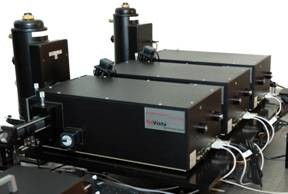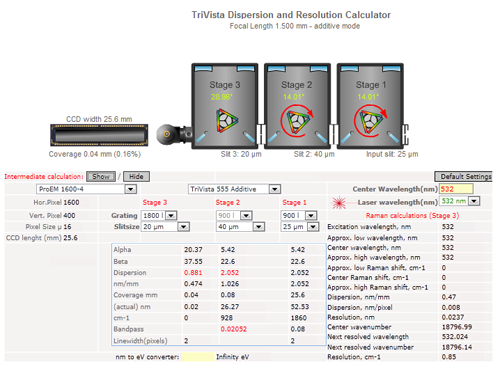
|
TriVista |
 |
|
Model |
Focal Length
|
Aperture Ratio
|
Spectral Resolution*
|
Dispersion*
|
|
TR555 |
1500 mm (A)
500 mm (S)
|
f/6.5
|
0.21 cm-1 (A)
0.6 cm-1 (S)
|
37 cm-1 /mm (A)
12.5 cm-1 /mm (S)
|
|
TR557 |
1750 mm (A)
750 mm (S)
|
f/9.7
|
0.17 cm-1 (A)
0.4 cm-1 (S)
|
34 cm-1 /mm (A)
8.5 cm-1 /mm (S)
|
|
TR777 |
2250 mm (A)
750 mm (S)
|
f/9.7
|
0.13 cm-1 (A)
0.4 cm-1 (S)
|
26 cm-1 /mm (A)
8.5 cm-1 /mm (S)
|
|
DM55 |
1000 mm (A)
|
f/6.5
|
0.29 cm-1 (A)
|
49 cm-1/mm (A)
|
|
DM77 |
1500 mm (A)
|
f/9.7
|
0.21 cm-1 (A)
|
37 cm-1/mm (A)
|
|
*with 1800g/mm grating at 500nm |
A - Additive Mode
S - Subtractive Mode
Designed to solve critical spectroscopy applications requiring high-resolution and stray light reduction, the TriVista system from Princeton Instruments provides researchers with the most flexible and high-performance system on the market today. TriVista is a triple spectrometer that can operate in either additive mode for high resolution experiments or in subtractive mode for extreme stray light rejection. With its multiple entrance and exit ports, researchers can configure several different experiments such as UV Raman or Photoluminescence and be able to switch between them via software control. The use of multiple laser wavelengths makes the TriVista a cost effective flexible tool for any Raman or multi-experiment lab. Consider the investment in several notch filters, which will need to be replaced in time, vs. the inherent tuneability of a triple spectrometer, which will give you many years of stable performance.
When performance and flexibility are key requirements, the TriVista is second to none!
At the heart of TriVista, are the industry leading Princeton Instruments' Acton Series spectrometers. They are known for superb resolution, stray light suppression, excellent imaging and ruggedness. The TriVista can operate from 200 nm up to 2.2 microns. Spectral resolution can be as low as 3 picometers over the entire range. Extreme stray light rejection allows Raman spectra to be captured as close as 5 wavenumbers from the Rayleigh line.
View the TriVista Dispersion Calculator (opens new window)

|

|
|
Typical CCD measurement in standard subtractive mode with gratings of 1800 l/mm in all stages. The collection is starting close to 0 cm-1. Sample is L-Cystine, excited at 632.8 nm by a 5 mW laser.
|
Features and Benefits
Variable bandpass tunable filter
Software controlled subtractive or additive operation
High-stray light rejection
Ability to see low frequency Raman bands as close as 5cm-1 from the laser line
Modular and flexible to accommodate multiple experiments
Multiple exit ports and input ports
Enhanced reflective coatings help achieve higher light throughput
Optional multi-purpose sample chamber
Kinematic grating mounts and motorized slits
Optional Stokes/Anti-Stokes accessory

